Oldham Athletic
Formed as Pine Villa by John Garland and his son, Fred, at a meeting in the Featherstall & Junction Hotel, within 16 years the club would graduate from local competition at junior level to the top of the Football League.
Having become Oldham Athletic in 1898, “The Latics” played their first game in the Manchester Alliance League in 1899 against Berry’s Blacking Works Second XI. Having finished as runners-up, the club moved up to the Manchester League the following year. In 1904 they graduated to senior level and became members of the Lancashire Combination B Division, winning promotion at the first attempt. An ambitious committee decided to form a limited company the following season and the campaign to join the Football League began.
After missing out on election by a single vote in 1906, they won the Combination title and reached the second round proper of the FA Cup only to be disappointed at the Football League AGM in June 1907. After the vote was taken, however, Burslem Port Vale resigned from the League and Oldham, as the strongest of the unsuccessful candidates, were invited to take their place. On their election, Oldham switched from their previous red and white shirts to blue and white stripes.
After only three seasons, the Latics won promotion to Division One and in the final season before the League was suspended, they finished as runners-up in 1915, only one point behind Everton. When competition resumed after the First World War, Oldham’s pre-war team was gone and, after four seasons of struggle, they were relegated to Division Two. In 1935, now wearing the distinctive broad blue and white striped shirts that would become their signature kit, Oldham sank into Division Three (North).
Immediately after the Second World War, Oldham turned out in red and white hooped jerseys borrowed from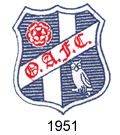 their neighbours, Oldham RLFC, presumably because the traditional shirts were not available.
their neighbours, Oldham RLFC, presumably because the traditional shirts were not available.
A badge appeared on the team's shirts between 1951 and 1954. The inclusion of an owl is a play on words and comes from the Oldham coat of arms: locals call the town "Owldham." A red Lancashire rose appears in the upper left quarter while the signature broad white stripe of their shirts is offset in upper and lower sections.
In 1953 The Latics returned to Division Two only to be relegated immediately and in 1959 and 1960 the club suffered the humiliation of having to apply for re-election to the Fourth Division twice in succession.
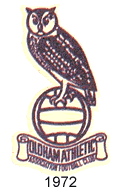 In 1963 the club’s fortunes improved with promotion to Division Three. Two years later the distinctive blue and white shirts were dropped in favour of a garish orange and blue outfit. After spending four seasons in the Fourth Division, Oldham won the title in 1971.
In 1963 the club’s fortunes improved with promotion to Division Three. Two years later the distinctive blue and white shirts were dropped in favour of a garish orange and blue outfit. After spending four seasons in the Fourth Division, Oldham won the title in 1971.
In 1972 they adopted a simple blue and white strip along with a simplified club crest featuring an owl on a football. They became champions of the Third Division and so returned to Division Two. Against the odds, the Latics not only survived at this level, they began to thrive under the management of Joe Royle, formerly of Everton.
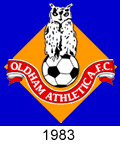 The introduction of red trim in the mid 1980s marked the beginning of a period of success. The crest was updated in 1983 and originally featured an orange diamond in the background, a reference to the club colours worn in
The introduction of red trim in the mid 1980s marked the beginning of a period of success. The crest was updated in 1983 and originally featured an orange diamond in the background, a reference to the club colours worn in 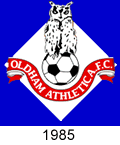 the 1960s. This was changed to white after a couple of seasons.
the 1960s. This was changed to white after a couple of seasons.
In 1990 the club reached the FA Cup semi-finals and were League Cup finalists. In 1991, to much astonishment, they won the Second Division championship and were back in Division One after an absence of 64 years. In the face of competition from the two big Manchester clubs, Oldham did well to stay in the top division for three seasons but relegation in 1994 was widely thought to have been inevitable. Immediately afterwards Royle left to rejoin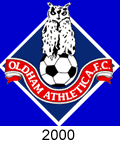 Everton as manager and in 1997, the Latics were relegated to Nationwide Division Two (the old Third Division).
Everton as manager and in 1997, the Latics were relegated to Nationwide Division Two (the old Third Division).
After 2000 the club crest generally appeared against a dark blue diamond outlined in white.
The club became insolvent in 2003-04 but was rescued by a consortium of British businessmen based in the United States who reformed it as Oldham Athletic (2004)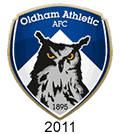 Association Football Club Limited.
Association Football Club Limited.
In the 2005-06 season the words "100 Years at Boundary Park 1906-2006" were embroidered round the badge on the home shirts.
For the 2011-12 season the club introduced a new crest. This appeared only on the away kit that season and was due to be added to the home kit the following season.
